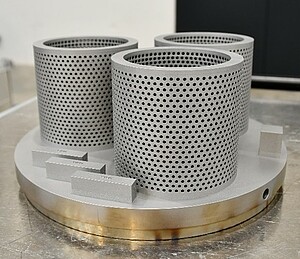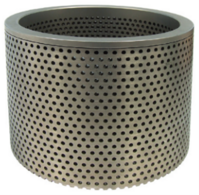
3D Printing: Manufacturing a Single Component Instead of Several Parts
SAMSON has started using additive manufacturing technology to produce standard valve trim parts. Since March 2021, SAMSON is a certified materials manufacturer for the additive manufacturing of parts made of 1.4401/316 and 1.4404/316L. SAMSON invested significant effort into mastering the laser-based powder bed fusion technology and optimizing internal production workflows until acceptable throughput times were achieved. SAMSON is now able to use the additive manufacturing technology to produce components for standard valve series as well as one-off customized parts for specific orders.
The technology is now being used to manufacture the flow divider 2, which was developed by SAMSON many years ago and is still used in its valves. The flow divider 2 reduces the noise emissions generated by the control valve and the attached pipeline in applications with gases and vapors. The number of units and the material mainly used to make this component in combination with work-intensive manufacturing process involved make it an ideal candidate for additive manufacturing.
So far, the component was made up of several parts, which were first machined and formed before being joined together. Thanks to additive manufacturing, the component is printed as a single piece on the support plate. As a result, no parts need to be joined together. This also means that no reworking or other production activities are required. This reduces the overall lead time. The quality and noise reduction performance of the flow divider made through additive manufacturing are equal to its conventionally manufactured counterpart.
Furthermore, additive manufacturing makes it possible to provide a 3.1 material certificate in compliance with DIN EN 10204 for every component since all possible or necessary test specimens can be manufactured at the same as the component. The component size is currently restricted to a 200 mm seat bore diameter and can only be made of 1.4401 and 1.4404 steels. The 3D printer used is a TruPrint 3000 by Trumpf.
The first components have already been dispatched to customers.
Temas relacionados
MainChange
Reguladores de presión de alimentación
Automatización
Medidor de presión diferencial
SIL
Válvula piloto
Oficinas de ventas
Configuraciones
Electroválvulas
Service
Careers
Digitalización
Relé de bloqueo
SAM TANK MANAGEMENT
Seminarios
SAM LAN
Consejo de Supervisión
Final de carrera
Válvulas
SAM DISTRICT ENERGY
Accionamientos
Media
Sede central
Conference
Industria 4.0
Filiales
Sistemas de automatización
SAM DIGITAL
Válvulas lineales
SAM GUARD
Consejo de Administración
Formación
FDI
Posicionador
Hydrogen
Accesorios
Reguladores sin energía auxiliar
Amplificador de caudal
Válvulas de control
Válvula de escape rápido
Compromiso

